When I think back to my childhood and teenage years, when my literary tastes were being forged in the crucible of youthful emotion and impressionism, particular scenes come to life: Sam carrying Frodo up Mt. Doom. The Reaper chasing Wil Ohmsford through the Westland. Marle hugging Crono on top of Death Peak.
Most fantasy readers won’t need a reminder of what books the first two scenes come from (Lord of the Rings by J.R.R. Tolkien and The Elfstones of Shannara by Terry Brooks), and most Kotaku readers won’t miss the reference to the classic Japanese role-playing game Chrono Trigger. And for some, all three of those works are of equal importance. Today’s fantasy novelists are just as likely to have been inspired by JRPGs as they are J.R.R. Tolkien. For some authors, Celes’ performance at the Opera House is just as much of a storytelling touchstone as young Simon fleeing Pryrates beneath the Hayholt.
Scott Lynch’s experience growing up with Japanese console RPGs “absolutely” influenced his later writing, he said. “Most specifically, the grandeur and atmosphere the Final Fantasy games evoked through their blending of magic with technology, and via their use of Yoshitaka Amano’s art and Nobuo Uematsu’s music.”
Lynch, 41, is one of fantasy’s most popular authors, with sales of over half a million copies of his 2006 book The Lies of Locke Lamora. What many of his fans might not know is that Lynch plucked the name for his titular character from Final Fantasy VI’s famous thief— err—treasure hunter, Locke Cole.
Scott Lynch is not the only popular fantasy author who has taken inspiration from Japanese role-playing games. Several contemporary writers I spoke with for this story told me that the JRPGs of the 1990s played a huge part of their adolescence and have influenced their work for over 20 years, including Tamsyn Muir, Max Gladstone, and Peng Shepherd.
A New Medium
On Twitter, I post mainly about two things: gaming, and science fiction and fantasy (SFF) books. As these two streams cross, I’ve noticed how they’re deeply entwined within the geek culture of 30-somethings. We grew up in an age where our childhood was equally filled with great books and the bleeding edge of the newly emergent video games field. But what is it about these golden-age JRPGs that specifically excited young readers in the 90s?
“Video games take our minds to alternate worlds and parallel universes,” wrote critic Nadia Oxford in 2016. “We meet fascinating people, struggle through epic conflicts, and interact with dragons and monsters. When we return to Earth, it’s not uncommon to feel a spark of inspiration that drives us to sit down at our keyboards, pick up a pencil, or break out our instruments.”
Due to misconceptions about video games—and their relative newness —much of the medium’s ability to foster creativity, learning, critical thinking, and imagination is lost on many people. The world’s first gamers are grandparents now, and we’re seeing the first generation of people who grew up knowing only a world with video games well into adulthood. It’s becoming more and more obvious that the power of video games to inspire creators is not only present in modern society, but immensely integral to the works of many of today’s young artists.
Alongside genres like point-and-click adventures and sprawling computer-based like Ultima and Baldur’s Gate, Japanese RPGs were at the forefront of wrapping their gameplay around a central narrative. The experience of playing these games was as much about the story as the systems and mechanics. JRPGs were also pulling a lot of narrative and world-building tricks that just didn’t exist in fantasy literature of the 90s. Dragon Quest and Final Fantasy looked to Western tabletop and computer RPGs for inspiration. With the influence of Eastern culture and a cavalier attitude toward established western tropes, Japanese creators like Hironobu Sakaguchi and Yuji Horii were able to craft experiences that felt at once familiar and new. Bold. Interesting. Different.
“Final Fantasy VII converted me,” said Troy L. Wiggins, 33, an SFF author and editor from Memphis, Tennessee. After Square’s groundbreaking PlayStation RPG, he moved on to other games he’d love even more, like Suikoden II, Wild Arms, and Star Ocean: The Second Story.
“I logged, no lie, thousands of hours in Star Ocean’s campaign,” he said. “All the stuff that I didn’t want to try to understand a couple years earlier suddenly was suddenly all I could think about. Grinding to level characters to get access to Special Arts. Running over old maps to find treasures. Falling in love with the simple, earnest characters, the byzantine plots, the ways that these distinctly different characters contrasted with the ones I found [elsewhere.]”

Wiggins’ short fiction has appeared in many of speculative fiction’s most popular publications, including Uncanny Magazine and Strange Horizons. He is also the Executive Editor of the Hugo Award-nominated literary magazine FIYAH: Magazine of Black Speculative Fiction.
Japanese RPGs represented fantasy without boundaries. Xenogears proved no idea was too big, Phantasy Star IV was the culmination of a multi-generational epic told across two consoles, and Lunar: The Silver Star showed how personal stakes could be just as enthralling as world-changing conflicts. One look at epic fantasy literature these days, and it’s impossible to miss the impact this no-holds-barred creativity has had on today’s writers.
Nintendo Generation
“I was a member of what you might call the Nintendo generation,” said Locke Lamora author Scott Lynch. Growing up near Saint Paul, Minnesota, he and his brothers worked paper routes to save up for an NES. “My mother diligently stored the money in a manila envelope on which she’d written INTENDO, bless her.” His early tastes revolved around action-based games like Mega Man 2 and Iron Tank, but that changed about a year later. “I made two simultaneous discoveries,” he said. “Final Fantasy at the local rental shop, and the fact that I could successfully feign illness to stay home from school and play Final Fantasy.”
“I think the most advanced and complete story of the 90s JRPGs was undeniably Chrono Trigger,” said Lynch “It is, by turns, whimsical, silly, mysterious, dark, and even frightening. It does a fantastic job of coherently integrating time travel, a story element which can easily get wildly out of control.”
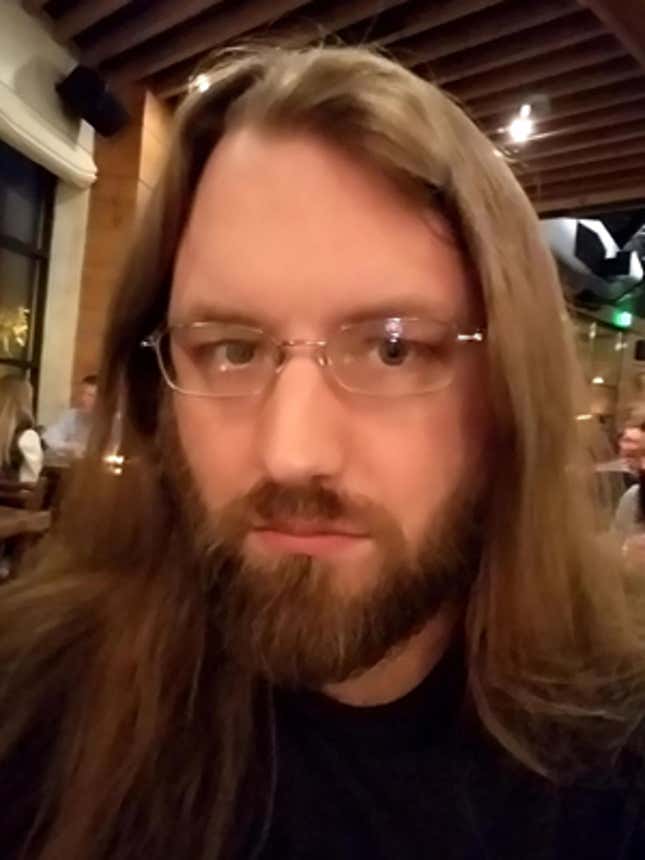
Lynch’s work features many elements that would be instantly familiar to JRPG fans, including sprawling cities, lots of magic, and a tight-knit band of knaves clawing their way through the world led by a charismatic protagonist who comes complete with a hidden magical lineage.
Lynch sees a larger trend of young SFF authors being influenced by gaming and Japanese RPGs. “Those of us in western commercial SFF... were exposed to anime, tabletop roleplaying, Wuxia films, Bollywood, JRPGs,” he said. “You know, all of these cultural currents that weren’t part of the standard curriculum for nerds of, say, the 1950s. That’s just bog-standard change over time. First these things are fringe interests outside their initial target markets, then increasingly normalized subcultures, and then just baked in to the overall cultural landscape.”
Lynch made an interesting point when I asked him how golden-age JRPGs differ from fantasy literature of the same era. “I think the most important factor was the relative ages of the mediums,” he said. “Western commercial fantasy at that point had established its model 25-30 years previously.” Lord of the Rings was a cultural phenomenon in the 60s, he said, but by the 70s, fantasy was more or less a niche market until Terry Brooks and Stephen R. Donaldson blew the lid off things with The Sword of Shannara and Lord Foul’s Bane respectively.
“JRPGs were still in what you might call their exuberant adolescence” in the 1990s, Lynch said. “The NES and SNES JRPG phenomena had all happened in just the last decade, give or take. So I recall there being a real sense of play and experiment along with the ambitions toward epic storytelling and themes.”
JRPGs themselves were influenced by the Western fantasy of the 1970s and 1980s, particularly Dungeons & Dragons. “I remember on the news channels we’d see about games like Dungeons & Dragons being played in America, and these fantastical stories about people dying for playing it too long, or how this game was amazing,” said Akitoshi Kawazu, creator of Square Enix’s SaGa game series, in a 2017 interview. “That entered our circle. We got our own localized version, and we thought we had to give it a go.”
Before creating the SaGa series, Kawazu was also part of the small team led by Sakaguchi that created the original Final Fantasy, consciously making it closer to the “fantasy lore and setting” of the Dungeons and Dragons series than its rival Dragon Quest was.
In a 2017 interview with Forbes, Final Fantasy director Hironobu Sakaguchi admitted that he looked toward Western RPGs for inspiration while developing Final Fantasy because he had no talent for action-based games. “I was thoroughly captivated by games such as Wizardry in the Apple II era, whose influence I cannot deny,” he said.” Sakaguchi also loved Western fantasy literature, being a particular fan of Elric Saga by Michael Moorcock.
Gideon Reaches Level 2
“Maybe the closest thing to a JRPG in novel form.”
When writer Isabel Yap tweeted this in January, I didn’t know much about Tamsyn Muir’s upcoming debut novel, Gideon the Ninth. But I immediately had to know more. I asked Yap, who had read the novel in advance of its upcoming September release, what made her say that. “Two things about Gideon the Ninth made me think of JRPGs,” she said. “It is extremely cross-genre in a way Tamsyn once described to me as ‘the kitchen sink’—it is a horror necromantic fantasy space opera, with large doses of humor, drama, and profanity. You’ve got technology, but you’ve also got powerful magic, and it’s all held together by tone and an utter sense of wholeness in the world she’s created.”

This should all ring true for Final Fantasy players, Yap said, who are very familiar with “traveling in airships and buggies—but also riding chocobos,” or using a cell phone to change party members alongside mystical Materia and summoning spells.”As a genre writer I’ve felt pressure to make my stories one thing—to suit an anthology theme, or submit to a certain market,” Yap said. Reading Gideon the Ninth was a “refreshing” experience, “sci-fantasy” that feels organic and right.
Gideon the Ninth might be Muir’s debut novel, but she’s a well-known staple of the SFF short fiction community thanks to her stories published in The Magazine of Fantasy & Science Fiction, Clarkesworld, and Lightspeed. Her 2015 novelette “The Deepwater Bride” earned nominations for (among others) the Nebula, Locus, and World Fantasy Awards. Before she was competing for awards, though, Muir cut her teeth writing “heaps” of fan fiction about her favorite Final Fantasy and Kingdom Hearts characters.
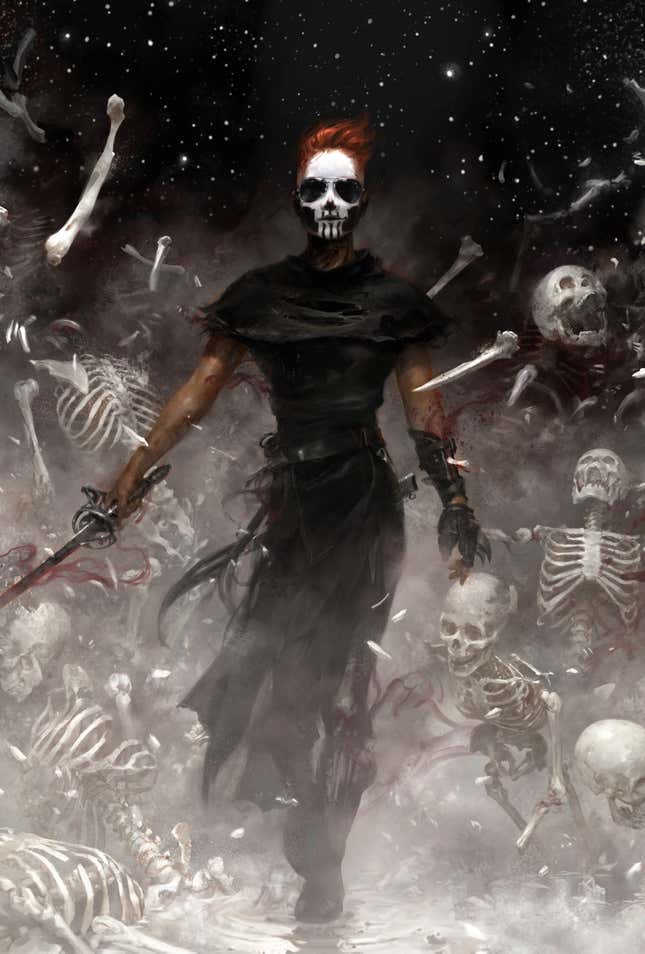
“I don’t know what it was about Final Fantasy VII and Final Fantasy VIII, but they took their humor seriously,” she said. “In my teens I wrote long stories for Final Fantasy VII involving Yuffie Kisaragi dying of a wasting disease and stories in Final Fantasy IX where Iron-tail Fratley dealt with being a single father. These were the cowboy years. You could do anything.”
“Writing those stories made me who I am,” Muir said. “I wrote them so un-self-consciously. I loved the characters. I loved the settings. JRPG fandom made you feel like you could write these massive epics without shame,” she said.
Gideon the Ninth’s “central conceit, the cavalier-necromancer duo, can definitely be looked at as a reworking of the JRPG fighter-mage dichotomy,” said Muir. The book plays around with the familiar trope of a young protagonist starting off in a cozy village before winding up in a “spooky celestial final temple,” complete with “big final boss” that changes form as their health is depleted.
“Gideon even begins the book by leaving her bed,” she said, a reference to the openings of so many JRPGs.
Fanfic Days
Fanfic is an art of its own—highlighted by the recent Hugo Award finalist Archive of Our Own, a fanfic hub that hosts a thriving video game community. It’s also a common entry point into writing fantasy and science fiction—nearly every writer I spoke with had a history with video game fanfic, and many didn’t stop writing it even after they landed traditional publishing deals for their creator-owned work.
Peng Shepherd’s 2018 debut novel, The Book of M, tells an epic story of survival in a dystopic future Earth. It won the 2019 Neukom Institute for Literary Arts Award for Debut Speculative Fiction, and was chosen by The Verge and Amazon as one of the best books of 2018.
“As a kid, I devoured any kind of story in any medium,” Shepherd, 33, said. “Books, movies, television, anecdotes from older relatives, gossip in permanent marker on the school bathroom walls. I’d been yearning to write fiction of my own ever since then as well—but never got very far with anything. I could invent fantastical premises at the drop of a hat, but I didn’t know how to build a narrative, or a world, or develop characters.”
The turning point, Shepherd said, was when she got a Super Nintendo at the age of 10. Her first game, recommended by her stepdad, was The Legend of Zelda: A Link to the Past. Shepherd became obsessed with Nintendo’s action-adventure game, and took control of the narrative when the game ended. “Writing fanfic is a huge part of how I discovered that I wanted to be an author in the first place,” she said. “I loved living in those stories, building believable relationships between characters who hadn’t interacted in the original game, and inventing new adventures to send them all on.”

“I don’t even think I knew the term ‘fanfic’ or that I was doing it until much later,” she said. “I just felt the overwhelming urge to keep the story going after I had beaten the game—so I did. I wrote. A lot.” Her Zelda fanfic would eventually become “Game Of Thrones-level detailed” and “intensely accurate.” She’d constantly reference back to the game to check minor details of the characters’ physical appearance. “It’s obvious looking back now, but this is clearly where I learned basic worldbuilding and character development skills.”
Like many young readers, Shepherd was obsessed with the characters and stories of her favorite books, but “there was something a little intimidating about trying to explore further in those stories once the pages had finished.” Video games were different, she said. The player was an active participant, which gave her a sense of ownership over the story that she didn’t get with books. “It felt easier to imagine a continuation of Link and Zelda and the Seven Sages’ lives after the quests had all been won,” she said. “The game had invited me to spend so much time pretending to be Link that it felt more natural to let my imagination run with the story.”
“There is often more you can mess around with as a fanfic writer” in video games, said SFF writer and editor Hayley Stone, 27. “A lot of the interiority of the characters is unknown or goes unremarked upon. Unless they announce their feelings on-screen, we don’t know how they feel about what’s happening, or about the characters around them. We can make educated guesses, however, and it’s in that space where fanfic lives.”
Despite an impressive list of publication credits that include Fireside Magazine and novels with Random House/Hydra, Stone still regularly writes fanfiction, which she said is a way to unwind and helps her appreciate the elements of storytelling and character that resonate most profoundly with her as a writer.
“My oldest and most favorite fandoms serve as personal touchstones whenever I begin to feel lost in my own writing,” she said. “I know I can always return to them for that little jolt of happiness and excitement, and then unpack why I feel that way.”
“If you boil it way down, the central storyline in The Book of M is essentially a quest to find a missing loved one,” said Shepherd, “plus several important side quests that reward the characters with new party members or key items to defeating the great evil, plus plenty of magic.”
Look closely enough, and you’ll see JRPG fingerprints all over modern fantasy. In “A Note from the Author” at the back of the 2015 book Skyborn, David Dalglish wrote about wanting to “tell a story about a civilization in the sky” ever since third grade, when he first encountered the land of Zeal in Chrono Trigger.
Similar to Shepherd’s The Book of M, Bryan Camp’s debut novel, The City of Lost Fortunes is set in a magical version of our world. The “first narrative I created out of my own brain,” said Camp, was “a sequel to Chrono Trigger I wrote when I was supposed to be paying attention in math class.”
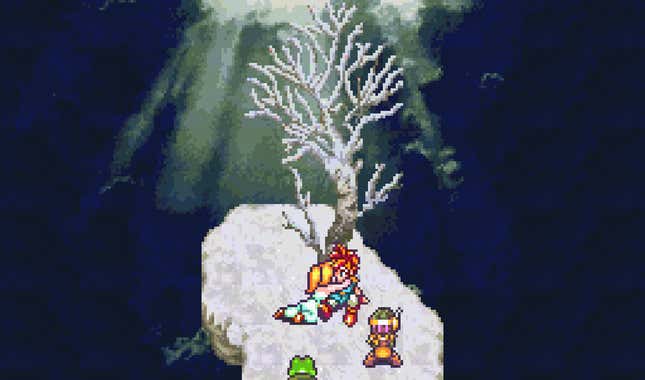
Whether it was Chrono Trigger’s floating continents, Xenogears’ imagery of a crucified Chu Chu, Serge becoming trapped in a Van Gogh-esque painting in Chrono Cross, or Earthbound’s all-around quirkiness, JRPGs in the 16- and 32-bit eras were weird. Super Mario RPG was a series of pratfalls. Secret of Mana let you visit Santa’s cabin in the woods. Final Fantasy V’s main villain was a tree. Final Fantasy IV culminated with players flying a whale to the moon. Lunar: The Silver Star even took place on the moon.
By ignoring tropes, these games helped create something wholly unique in fantasy. Golden age JRPGs were unshackled by any adherence to “realism.” They weren’t stories trying to recreate political or social realities from human history—they were stories about planet-destroying meteors, time travelling witches, and whole cities that could awaken into enormous eidolons.
“So much ‘90s fantasy mirrored the tone of the time: dark, gritty, violent, and complicated,” said Troy L. Wiggins. “The best JRPG stories were about more or less positive things.”
“The later Final Fantasies managed to strike what I found was an incredible balance between taking themselves extremely seriously and taking themselves not seriously at all,” said Tamsyn Muir. “I love the juxtaposition of these huge, epic stories sitting with absolute comfort next to frog-eating minigames and that time in Final Fantasy VII where you have to find Cloud Strife the best wig.”
Final Fantasy “landed on hundreds of thousands of people roughly my age with the full force of delightful novelty,” said Scott Lynch. “The message of the Final Fantasy aesthetic was that you could unchain yourself, be more glib and flexible with your elements.”
This tendency to steer old ideas in new directions—to limit their worlds and magic system not by what could be realistically justified in a book, but only by the boundaries of their creators’ imaginations—allowed JRPG creators to show to readers that fantasy could be so much more than pastoral Tolkien rip-offs.
“If you look at the three JRPGs that were the most formative of my adolescence,” Bryan Camp said, “there’s not a whole lot that is out of bounds. Time travel, aliens, magic, cybernetics, floating cities, zombies, and apocalyptic threat after apocalyptic threat.”
“In my books there are magicians who make Ghostbusters references and sorcerers who enchant software,” he said. “In my current project, there are clockwork automatons and language magic and god-beings who are maybe aliens and a street where it’s eternally night. Put some turn-based combat in there and give the protagonist some spiky hair, and it’d be right at home on the PlayStation.”
Grown-Up Fantasy
Perhaps one of the most important contributions that JRPGs have made to fantasy is how they implemented elements of decolonization—the act of uncoupling SFF narratives and world building from the systemic tools of oppression that strip colonized peoples of their history, stories, and identity, while recentering the narrative on those voices—into their stories, suggests R. Kiran Gopal, a millennial fantasy writer and former associate editor at PodCastle.
“JRPGs showed me that the Tolkien pastiche didn’t have to be Eurocentric,” he said. “They tend to take a kitchen-sink approach to fantasy as well as prioritizing moods, themes, and atmospheres over granular world building. Those things encouraged me as a young writer to think of epic fantasy as a toolkit or palette to draw from instead of a form to be constricted by.”
JRPGs tended towards indifference toward the historical origins of western fantasy tropes, Gopal said. “It can be really freeing when you’re a teen fantasy nerd and don’t know anything about the War of the Roses. Western epic fantasy tends to come packaged with a sense that historical accuracy is really important, which usually ended up being a specific mythologized version of medieval European history that’s typically not all that accurate and rarely apolitical. JRPGs showed me there was no price of admission to the genre.”
Today there are many examples of popular decolonized fantasy. Marlon James’ Black Leopard, Red Wolf is a brutal, politically-charged epic fantasy set in an African-inspired world. N.K. Jemisin’s three-time Hugo-winning The Broken Earth trilogy paints one of the genre’s richest and most compelling worlds. Ken Liu’s massive series, The Dandelion Dynasty, is an epic fantasy that takes cues not only from Beowulf and the Aeneid, but also Sima Qian’s Records of the Grand Historian and Chinese wuxia novels.
“One of the things I loved about Final Fantasy X is how unabashedly it threw away the standard medieval European fantasy setting,” said Wiggins. “Final Fantasy VII got praise for being a cyberpunk story, but I think we owe X some applause for its unique takes on faith, its strange non-European inspired setting filled with brown people and a noticeable brown minority group, and the unique mythology driving its main antagonist.”
Before Final Fantasy X, there were was Junko Kawano’s Suikoden series. The first two games on PlayStation were revolutionary at their release for many reasons. One was their astronomically large casts, allowing players to recruit up to 108 characters over the course of the game. Another was how they took the typical high fantasy formula and added a complex layer of social and political stakes to the mix.
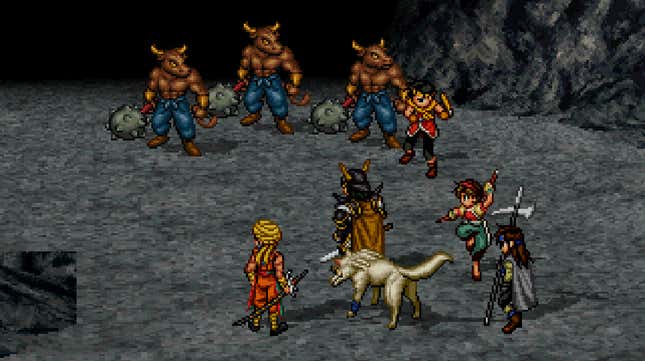
Suikoden II was “the first time that I saw an unabashedly political story in a JRPG,” said Wiggins. “It was fundamentally different because it is more of a sociological story than we typically get in standard JRPGs. It had extremely complex messaging, and I dug that.”
The Suikoden games were JRPGs full of “proxy wars and ascendancy assassinations and genocide,” he said. “Other JRPGs dabbled with these ideas, but in a much less mature way. Suikoden II showed me that it is possible to tell a high fantasy story that shows the smaller, personal ways in which our lives are shattered not just by rogue magical beings, but by the monsters that we create—be they war, sociopolitical systems, or simple human greed.”
Alongside Kawano’s games, Yasumi Matsuno’s work on Ogre Battle, Final Fantasy Tactics, and Vagrant Story further illustrated that JRPGs could tell unique, politically complex, and mature stories as compelling and rich as any novel.
So many of the fantasy novels I was reading in the ‘90s focused on young, naive men coming of age in a large world. Matsuno’s narratives featured capable, grizzled protagonists and characters that did not have to carve out an understanding of the world. Ashley Riot, a powerful Riskbreaker of the Valendia Knights of the Peace, explores the ruins of Leá Monde with tools and experience at his disposal that would place him among the Aragorns and Lan Mandragorans of the world. Even Ramza Beoulve, the young protagonist from Final Fantasy Tactics, was a member of the aristocracy with all the schooling and military training one would expect of the ruling elite. These were people with histories, or from consequential families of power, and their conflicts spun outward from there, shaping the world around them not by accident or surprise but with intent and purpose.
Final Fantasy Tactics’ story “has all the weight and intrigue of a Shakespearean tragedy,” Greg Kasavin, Developer at Supergiant Games and former editor-in-chief of GameSpot once told Kirk Hamilton here on Kotaku.
Matthew Burns, founder of Shadegrown Games, appreciated the game’s narrative framing device, an imprecise historian recalling past events with murky accuracy. “It presents the player with a sweeping look at people, politics, and events without itself getting too caught up in any of its own characters’ emotions and causes.”
Jeremy Parish, podcaster and former EIC of USgamer, cites Matsuno as “perhaps the most idiomatic character to pass through the halls of Square.” Final Fantasy Tactics was not Matsuno’s first game, Parish continued, “but it was the first to reach a large audience, and it introduced millions of gamers to his personal obsessions: intricate plotting, nuanced characters, and historical verisimilitude.”
How many of those millions of gamers tuned into Game of Thrones, their love for labyrinthine, sometimes incomprehensible epic fantasy storytelling borne by their experience with Final Fantasy Tactics in the late ‘90s?
More than a few, I’d bet. In fact, I’m one of them. It’s no surprise I discovered the works of Robin Hobb and George R.R. Martin around the same time I was obsessed with Final Fantasy Tactics and Suikoden II. Matsuno and Kawano weren’t the first to introduce this style of character and storytelling—look no further than Final Fantasy VI for a game that featured older, experienced protagonists—but they ignited my passion for fantasy narratives that also work as complex sociopolitico epics about humanity’s shifting winds and the perils of progress for the sake of ambition.
Canny Valley
As I revisit the games of the 16- and 32-bit generations today, in my 30s, I’m struck by how much work the pixel-based and early 3D graphics do to make up for the games’ technical limitations. Where today’s games are expansive and packed with detail—guiding the player’s perception of the world down to the individual beads of sweat on their avatar’s forehead and blades of grass in mountain fields touched by wind—older games were more of a symbiosis between the game’s graphics and the player’s imagination.
“No shade thrown to the PlayStation, but there’s something magical about the art that springs from SNES hardware,” said Max Gladstone, 34, the Hugo-nominated author of Empress of Forever. “Just enough power to do cool things, not enough to get lost in your own creative ambition,” he said. “Beauty emerged from those constraints.”
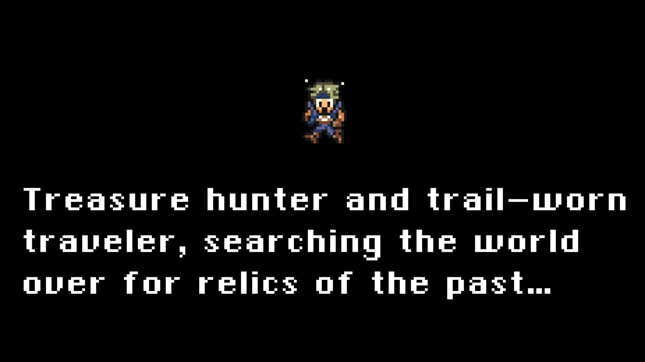
Kazuko Shibuya’s sprite work in Final Fantasy VI is charming and beautiful, but I didn’t know what Locke looked like while playing Final Fantasy VI. Not really. Sure, the art in the game’s manual gave me an idea, but, as Locke bounded about the television, I had to imagine how the details were playing out. How did his behaviour change when he was infiltrating South Figaro? How did he move and act when he was around Rachel? What’s his body language like when he’s with Celes? Shibuya never achieved the same level of fame as Squaresoft’s other masters from the time, but without her work it’s unlikely the Final Fantasy series would have achieved its iconic and lasting look. (Check out this interview with Shibuya on Shmuplations for a great overview of her career.)
Final Fantasy VI was a masterclass in using simple sprites to convey a lot of character, but much of the nuance was left up to the player—a lot like reading a book.
Even games with larger and more animated sprite work like Trials of Mana or Breath of Fire IV still fell on the impressionist end of the scale. Contrast that to today’s games, where set pieces are intricately detailed, character models feature an enormous number of polygons and detailed textures, and cut scenes utilize motion capture and camera angles to impart particular emotions on the player. It’s beautiful and easy to get lost in those worlds—but it’s different. Fewer of the details are left up to the player, and the experience is closer to an interactive film than reading a book.
Change The World
While there’s similarities in how these older games and books asked readers and gamers to collaborate on the unified vision for their aesthetic and visual elements, the games took one more step forward by giving the player agency within the narrative, and were not afraid to throw truly unexpected events at the player.
Crono’s sacrifice, the destruction of the World of Balance, Aeris’ death—all of these twists were legitimate game changers on par with Frodo’s claiming of the ring, only they happened mid-game, not during the climax. These were huge plot twists that not only surprised the reader, but set the stage for the rest of the narrative. Do you try to resurrect Crono, or take immediate vengeance against Lavos? The entire gameplay structure of Final Fantasy VI changes after Kefka destroys the world, and the player must reassemble their party one character at a time. Or not. Ultimately, it’s not just that the worlds feel truly changed by the game events, but that the player had a hand in executing those changes.
“In books, everything is laid before you, there is nothing left for you to discover,” said Chris Melissinos, guest curator of The Art of Video Games at The Smithsonian American Art Museum, as reported by Nadia Oxford in USgamer’s “Teaching Creative Thought and Expression Through Video Games.” “Video games are the only forms of artistic expression that allow the authoritative voice of the author to remain true while allowing the observer to explore and experiment.”
My first attempt to write a novel came in my early 20s. The PlayStation 2 was the hot console for JRPGs, but my heart was still snagged on something a little older. Beyond Eridessys was an original epic fantasy novel following a war between two elvish societies. In reality, though, it was veiled fanfic of Working Designs’ Lunar series. I used to haul my PlayStation and my trusty Commodore 1702 monitor over to my friend’s house and we’d set up side-by-side and play Lunar: Silver Star Story Complete in parallel, trying to keep pace with each other, comparing notes and strategies while trying to avoid spoilers. It was one of the formative experiences of my teenage years, and, no surprise, I gained a strong emotional attachment to the series. You didn’t have to look too closely to see the Lunar serial numbers scratched out on Beyond Eridessys: It was secretly set on the moon, was chock full of adventures, and even featured a rapscallion named Dyne.
Beyond Eridessys fizzled out after about 30,000 words, but the mark left by JRPG narratives and my desire to translate that emotional attachment into words and stories never went away.
Looking back, and understanding more about Akitoshi Kawazu and his particular brand of wackiness, I feel pity for that younger version of me, blissfully confused by Final Fantasy Legend II’s weirdness. When I first laid eyes on it, I had no idea so much of my life would be influenced by its director Kawazu and his contemporaries. I grew up on Vancouver Island in British Columbia, a world away from where Sakaguchi, Kawano, and Matsuno worked creating their legendary games, but their influence was global. Life is a circle. In the same way that the earliest JRPGs were influenced by western tabletop and computer-based roleplaying games and literature, those games are now central inspirations for some of the most exciting young SFF authors publishing today.
As a kid, with my love of writing blossoming, video games and fantasy novels provided me with endless opportunities for adventure and escape. I fell into both equally, and, in that way, became the storyteller I am today. It’s impossible for me to separate the two influences. They represent thousands of threads in the vast tapestry I am unfurling with each new story I tell.
“I don’t remember when it started exactly,” says aspiring Dragonmaster Alex at the beginning of Lunar: Silver Star Story Complete, “but the dream of having a fantastic adventure in far-off places grabbed my heart early and has yet to let go.”
Unlike Alex, I remember precisely when it started.
Aidan Moher is a Hugo Award-winning editor, the author of “Youngblood,” “The Dinosaur Graveyard,” and “The Penelope Qingdom,” and a regular contributor to Tor.com and the Barnes & Noble SF&F Blog. He lives on Vancouver Island with his wife and kids, but you can most easily find him on Twitter (@adribbleofink) or his website.

